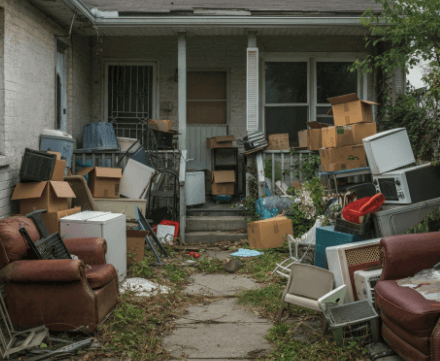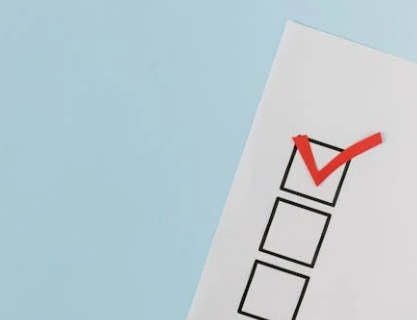Cleaning up a hoarded property can be overwhelming. The process is complex, sensitive, and often emotionally charged, demanding tact, strategy, and a careful step-by-step approach. This comprehensive hoarding clean-up checklist is designed to guide you through this process, ensuring you address all aspects efficiently and compassionately. For many, hoarding is a multifaceted issue that requires long-term management, but starting with a hoarding clean-up checklist is often the first critical step. Whether you are a land seller, property owner, resident, or investor, navigating the delicate process of hoarding clean-up is essential for the community’s well-being, the individual’s health, and the realization of a property’s potential.
Real estate investors Steve Daria and Joleigh have developed a foolproof method for efficiently managing hoarding clean-up. By following their comprehensive Hoarding Clean-Up Checklist, you can transform chaos into order seamlessly. Their expert tips ensure a stress-free and systematic approach to decluttering your home.
Assess the Situation
Before diving into the hoarding clean-up checklist, a robust assessment of the property and the hoarding situation is necessary.
Understanding Hoarding Behavior
Before tackling any hoarding clean-up, a robust assessment of the property and the hoarding situation is necessary.
This critical step lays the backbone for the entire process and clearly explains the work ahead. Begin by learning about hoarding disorder.
Understanding its psychological and emotional components can guide your approach and help you design a more effective clean-up plan that considers the individual’s needs.

Safety First
Assess the physical condition of the property.
Hoarded environments can pose significant safety hazards, such as tripping or falling, exposure to biohazards, structural damage, and fire risks.
Prioritize safety for all involved.
Engage with the Community
Connecting with support groups, social services, and mental health professionals can provide valuable insights.
It also helps establish a support network for the affected individual and the clean-up team.
Get An Offer Today, Sell In A Matter Of Days
Develop a Comprehensive Plan
A step-by-step plan is essential to ensure that everything is noticed and to create a structured timeline for the clean-up process.
Setting Goals
Define success for your clean-up operation.
This could include restoring the property to livable condition, selling the property, or reclaiming a usable space.
Sorting Strategy
Develop a system for sorting items into categories: keep, donate, sell, recycle, and discard.
Decide on a methodology for sorting that ensures a thorough yet respectful approach.
Timeline and Milestones
Break the clean-up process into manageable phases.
This could be by room, by type of item, or by chronological order.
Establish deadlines for each phase to keep the project on track.
Organizing Resources
Identify the resources you’ll need, such as waste disposal services, cleaning supplies, storage units, and labor.
Make arrangements for these resources to be available when needed.
Preparing the Property
Preparing the property for clean-up involves more than logistics.
It also involves preparing any involved parties for the process.
Communicating with the Hoarder
Open and honest communication with the hoarder or their representative is crucial.
Discuss the clean-up plan, including its necessity and approach and any support the individual may need during and after the process.
Educating the Team
If you’re working with a team, ensure everyone understands the sensitivities around hoarding.
Effective handling of situations requires training in empathy and respect.
Addressing Legal and Ethical Considerations
Understand the legal implications of hoarded properties, such as landlord-tenant laws and any relevant health codes.
Develop a protocol for handling legal matters related to the clean-up.
Execution of the Clean-Up
With a clear plan, it’s time to begin the physical work of cleaning the property.
Team Coordination
Ensure your team is clear on their responsibilities and the sequence of the clean-up process.
Team leaders should be designated for each phase to maintain organization and oversight.
Decluttering and Sorting
Start with small, manageable areas to build momentum.
Clearly label items and ensure the hoarder is involved in the decision-making, as much as possible, to empower them.
Deep Cleaning and Sanitizing
After clearing the space, undertake a deep cleaning to remove accumulated dirt and potential biohazards.
This may require professional cleaning services to ensure a thorough job.

Repairs and Restoration
Check the degree of damage to the property and make the necessary repairs.
This could include fixing walls, floors, and ceilings and addressing any structural issues discovered during the clean-up.
Managing the Emotional and Psychological Impact
The emotional toll of hoarding clean-up can be significant for the hoarder and those involved.
Offering Support
Ensure the hoarder has access to support services throughout and after the clean-up.
These could include therapy, hoarding support groups, or individual counseling.
Team Debriefing
Make regular check-ins with your team to discuss any emotional challenges they may face.
Provide resources for coping, such as counseling or peer support.
After-Care Planning
Plan for the long-term maintenance of the property and the emotional well-being of the hoarder.
Discuss strategies to prevent re-accumulation of items and to maintain a healthy living space.
Finalization and Reintegration
The final stages of the clean-up process involve reintegrating the property into safe use and supporting the hoarder’s ongoing recovery.
Final Inspection
Conducting a final inspection of the property is essential to ensure it is safe, clean, and compliant with all legal and health regulations.
This may involve enlisting the help of local authorities or health inspectors.
Documentation and Record-Keeping
Maintain thorough documentation of the clean-up process, including before-and-after photos and any relevant paperwork.
This documentation is valuable for future reference, legal matters, and increasing awareness.
Continual Support
Continue to offer support and resources to the hoarder.
Connect them with long-term support systems and help them maintain order in their living environment.
FAQs about Hoarding Clean-Up Checklist
Find answers to the most common questions about the hoarding clean-up checklist.
What if the hoarder is resistant to the clean-up?
Approach with empathy, communicate openly and involve mental health professionals to provide support.
How do I handle biohazards?
Use professional cleaning services equipped to handle biohazards safely.
How can I prevent the re-accumulation of items?
Develop a maintenance plan, provide ongoing support, and connect the individual with support groups.
Conclusion
Taking on the challenge of hoarding clean-up is an enormous undertaking that requires a systematic approach, sensitivity, and ongoing commitment. This hoarding clean-up checklist is not just a guide to cleaning up a hoarder’s property; it’s a roadmap for a process that respects the individual, the community, and the property involved. It aims to transform a distressing situation into one that empowers and facilitates positive change.
If you face a hoarded property, remember it’s a complex issue with no one-size-fits-all solution. Every hoarding situation is different, and the approach must be tailored to the unique circumstances. Seek professional guidance, maintain open communication, and approach the process empathetically and patiently. With the right strategies in place, a hoarding clean-up can be a significant step towards reclaiming spaces and lives.
**NOTICE: Please note that the content presented in this post is intended solely for informational and educational purposes. It should not be construed as legal or financial advice or relied upon as a replacement for consultation with a qualified attorney or CPA. For specific guidance on legal or financial matters, readers are encouraged to seek professional assistance from an attorney, CPA, or other appropriate professional regarding the subject matter.

